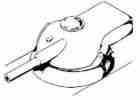Articles >>
Oscillating Turret
Category: Term of the day

The oscillating turret is a two-piece turret where the bottom half allows a 6400 mils (360 degrees) rotation on a conventional turret ring, but the upper half is mounted on trunnions at either side. The gun is fixed in the upper part of the turret and gun elevation and depression is obtained by tilting the whole of the upper part of the turret. The main advantage from this system accrues from the gun being fixed in relation to the upper turret. The sighting and fire control system are greatly simplified as there was no need for complex mechanical linkage between gun and sight (in a modern application the linkage would be electronic) since both are mounted in the upper part of the turret and move together. As the gun is fixed to the upper turret, the swept volume requirement inside the turret due to the elevation and depression is also greatly reduced. The gun can be mounted close to the turret roof and so reduces the frontal area presented to the enemy when engaging a target with the main armament. Because the gun is fixed in relation to the upper turret, a human loader would have a very difficult task and therefore an autoloader is essential. The loader can be eliminated, reducing the silhouette of the tank and enhancing protection. The attraction of a simple autoloader is lost if the magazine is positioned anywhere except in the bustle, where the ammunition maintains a constant position relative to the gun and breech. Problems then arise in light tanks where there is a limit to the number of ready rounds of ammunition available. Ammunition magazines mounted on oscillating turrets usually have to be replenished from the outside and if the magazine has a small capacity the need to expose the crew to reload could be a serious operational disadvantage for a tank in battle though it would not be of such critical importance for a tank destroyer.
Apart from the limitations on the quantity of ready rounds that can be stowed in the turret bustle, the weight problems are increased very considerably when the vehicle is scaled up to main battle tank (MBT) levels. The sheer weight of the upper turret, which includes armour, gun, ammunition and autoloader, necessitates very considerable gun trunnions and large amounts of hydraulic or electrical power for stabilisation. These trunnions have, in turn, to be supported by a substantial thickness of metal in an area where the protection levels (the sides) would not necessarily require such thickness. NBC protection is particularly difficult to provide in an oscillating turret. Practically all armoured fighting vehicles rely on crew compartment over-pressure as a means of countering the inevitable leakage mainly from the hull/turret interface. However, the gross leakage caused by the inability to seal effectively the upper and lower halves of the turret and the turret ring itself renders it impossible to utilise a collective NBC protection system. |
New Upgrades Enhance Sighting and Add More Firepower to LCT20 Turrets
08.09.2011
Tank Firepower
19.03.2009
Anti-Tank Guided Missile
02.04.2007
Cleft Turret
14.11.2006
Discuss
